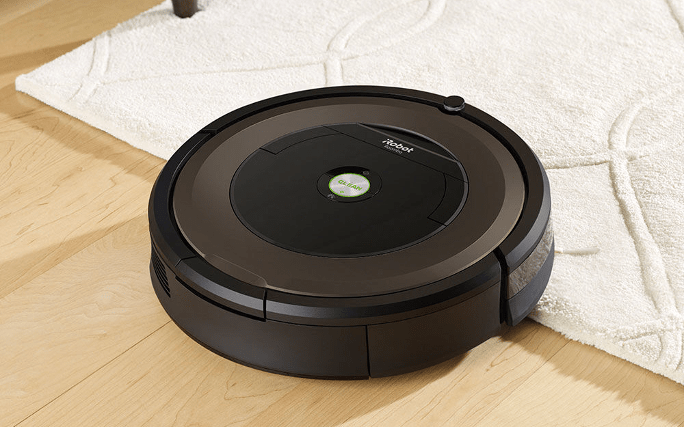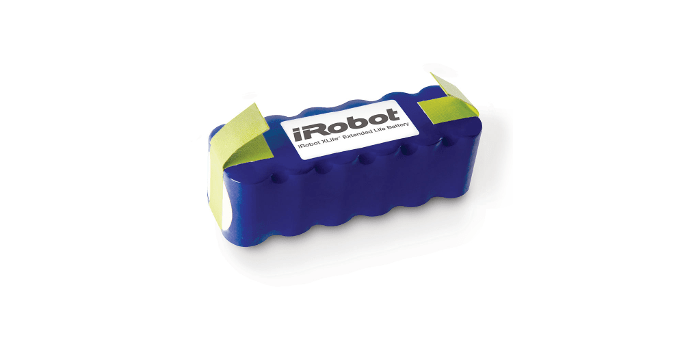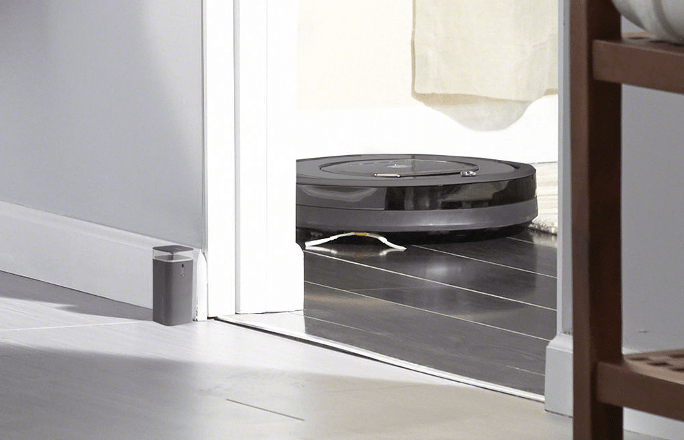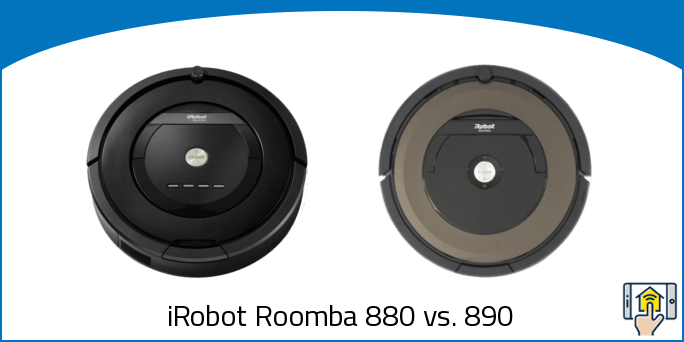There’s little worse than coming home from a long day of work to be greeted with a long list of house chores. But what if you could take some of the hassle away with a handy robot cleaner? Smart vacuums can do just that by keeping your floors clean on an automatic schedule.
The Roomba 890 is the best of the best in Roomba’s 800 series. It offers excellent performance, an attractive design, support for WiFi, and more in order to make it one of the brand’s best vacuums to date. The price difference between the iRobot Roomba 880 vs. 890 is also minimal, which makes it easy to get superior features without breaking the bank. (Check the price on the Roomba 890 now.)
Below we dive into the similarities and differences between the two vacuums to hopefully make your decision a little bit easier. They share a lot of the same features, but they may be difference enough to sway your choice one direction or the other.
iRobot Roomba 880 vs. 890 — Things in Common
-
Finds Dirt and Debris – The 880 and 890 both do a great job of detecting dirt and debris. The vacuums use iAdapt first generation navigation and mapping software to learn the layout of your home and keep your floors clean. The Dirt Detect Series 2 technology takes advantage of optical and acoustic sensors in order to locate dust and dirt and concentrate cleaning on the areas where it’s most needed.
-
Avoids Stairs – It’s really convenient to be able to use the Roomba to clean your upstairs bedrooms, but with any sort of technology that runs around on its own, there’s always the risk that it could take a tumble down your stairs. That shouldn’t be an issue with the 880 and 890, however, as they feature cliff-detect sensors that help the Roomba avoid stairs, obstacles, and loose wires.
-
Cleaning Schedules – Both of these models have support for cleaning schedules. One of the main advantages of a robot vacuum is the ability to have clean floors without worrying about cleaning. You can schedule the 880 or 890 to clean once per day, up to seven times per week — keeping your floors clear of dust and debris on a regular schedule.
-
Noise – One downside to both of these models is that they’re quite loud. While they’re cleaning your floors, it’s pretty difficult to have a conversation or watch TV without cranking up the volume a good deal.
This shouldn’t be a deal breaker for either device, as one of the advantages of scheduling is the ability to set it to clean while you’re not home. Choose a cleaning time while you’re away at work, and come home to pristine floors and a Roomba that’s parked in is dock to charge.
With that said, Roomba does offer some models that are significantly quieter. If the noise is a concern, check out our comparison on the iRobot Roomba 960 vs. 980 for a much less noisy model.
For a sense of how loud the vacuums are, these models produce around 65 decibels of noise while vacuuming hardwood. This is actually much quieter than a traditional vacuum, but it’s still loud enough to distract you from normal activities. On carpets, it’s much quieter at just 60 db.
-
Brushless Mechanism – Traditional vacuums use brushes to pick up dust and debris. This is an efficient manner of cleaning, but it has one major downside: maintenance. It might not be the end of the world to have to pick up your vacuum and pick out bundles of pet hair, but it’s definitely annoying and a hassle that the Roombas are able to avoid due to their brushless mechanisms.
To clean the floor, the 880 and 890 agitate the dirt and knock it up into the path of the suction, which will quickly suck it up into the bin. The lack of brushes means that you shouldn’t have to worry about picking up your Roomba to remove clogs — making for a robot vacuum that you can truly set and forget.
-
Vacuums Along Wall Edges – Because the Roomba is circular, one of the first thoughts that might come to mind is whether or not it can vacuum around walls and other straight surfaces. Rest assured that both models are equipped with Wall-Following Technology. This tech allows them to come up close to the walls and follow along, sweeping dirt into its suctions in a smooth motion to keep every inch of your room clean.
-
Anti-Tangle Technology – You might be worried about your Roomba getting caught on cords or fringe. After all, if you’re not keeping an eye on your device, how can you be sure that it’s avoiding obstacles?
While you should do your best to ensure that the floor is relatively clear of cords, you shouldn’t have to worry about your Roomba getting suck on them or causing damage, as it features Anti-Tangle Technology that keeps it cleaning your room with maximum efficiency.
iRobot Roomba 880 vs. 890 — Differences

-
Difference #1: Remote Control – Let’s kick things off with perhaps the most notable difference between the Roomba 890 vs. 880: the control scheme.
The iRobot Roomba uses a remote control in order to program the vacuum and control the various settings including starting the cleaning, making a schedule, and calling for a spot clean. You have to be within 15 feet of the Roomba in order to use the remote, as it has a limited range.
The 890, on the other hand, uses the iHome App — available for both iOS and Android. This is a major advantage, as it offers a clean, intuitive interface that allows you to control your Roomba as long as it’s hooked up to WiFi. You can control your Roomba from wherever you happen to be — even if you’re at work or on vacation!
To put it simply, the 890 has a significant advantage over the 880 due to the easy-to-use app control. Being able to adjust settings through a convenient interface on your phone rather than a remote where you have to be within 15 feet is a major reason why the 890 is a superior vacuum. If you don’t need the ability to control your Roomba from wherever you happen to be and don’t need the features that the app offers, however, the remote should work just fine.
-
Difference #2: Coverage Maps – Because the 890 uses the iHome app rather than a remote control, it has a number of additional features: one of those being coverage maps.
Coverage maps are a cool feature that allow you to zoom and pan around Clean Map reports in the history screen. By doing so, you can view the cleaning coverage as well as any areas with concentrated dirt where the robot focused during its session. Additionally, you’ll have access to useful statistics such as the area cleaned, the job duration, and charging time for completed jobs.
While it’s not a necessary feature by any means, it’s a neat utility that allows you to get a sense over just how effective your new robot vacuum is. It might also be able to give you a sense of areas that your Roomba is neglecting, allowing you to move any obstacles that might be blocking its mapping and travel.
The 880, unfortunately, does not have this feature as it doesn’t have access to the iHome app nor the ability to hook into your WiFi network.
-
Difference #3: Wall Barriers – One area that the 880 actually has an advantage over the 890 is in the way it handles Wall Barriers.
The Roomba vacuums are great to have in your home, as they can efficiently map out an area and clean an impressive area in a single cleaning session. However, for one reason or another, you may wish to block off certain areas of your home that you don’t want your Roomba to access.
Fortunately, both the 880 and 890 offer an efficient way to do so in the form of Wall Barriers. They differ, however, in how they approach the task of keeping your Roomba in a specified area.
The 880 uses Virtual Wall lighthouses. These are beacons that you can set up in certain areas in order to keep your vacuum from leaving an area until the current area is clean. The Roomba will send a signal to the lighthouse that alerts it that the current area is clean, and then the node will disable the barrier and allow it into the next area. You also have the option for Virtual Wall mode, which will outright block the vacuum from entering an area — keeping specific areas private and free from intrusion.
With the 890, Roomba has replaced the lighthouses with the more simple Virtual Wall Barrier. These barriers can be strategically placed to block off certain areas — similar to the wall mode on the lighthouses. However, they don’t have the ability to contain the Roomba until cleaning is finished before granting access to the next area. This gives the lighthouses an advantage due to that extra feature.
-
Difference #4: Battery Life – Another area in which the 890 has an advantage over the 880 is in its battery life.
With the 880, iRobot used a Nickel Metal Hydride battery with up to 60 minutes of running time. The 890 upgraded to a lithium-ion battery with a 120 minute running time. A 100% increase in battery life is a pretty significant difference, as it allows the Roomba to cover a much larger distance in a single cleaning.
It’s worth mentioning that the 890 doesn’t seem to reliably run for 120 minutes each and every time. With that said, it’s still a major improvement over the 890 due to the more efficient and faster charging lithium-ion battery tech.
-
Difference #5: Buttons – While the 890 offers easy control through the smartphone app, the upgrade to the newer model seemed to have removed some options for manual control.
The 880 has schedule buttons on the unit itself, which allowed homeowners to control the settings directly on the vacuum. The 890 seems to have ditched these features, and the only way to control its settings is through the iHome app.
This might not be a significant disadvantage, as the majority of people always have their smartphone at hand. However, the ability to quickly adjust schedules with a few taps of a button is certainly an advantage that the 880 has over its newer sibling.
-
Difference #6: Voice Control – One feature that makes the Roomba 890 smart vacuum truly feel “smart” is the inclusion of voice control. Using Alexa or Google Assistant, you can issue commands to control your Roomba without lifting a finger. It’s a useful utility that makes the 890 a little more convenient to use for those with these smart assistants, and it’s a clear advantage that the newer model has over its predecessor.
iRobot Roomba 880 vs. 890 — Comparison Chart
| iRobot Roomba 880 | iRobot Roomba 890 | |
|---|---|---|
| iAdapt | Yes | Yes |
| iRobot Home App | No | Yes |
| IR Remote Control | Yes | No |
| Recharge & Resume | No | No |
| Run Time | Up to 60 minutes | Up to 120 minutes |
| On-board Camera | No | No |
| Brushless Mechanism | Yes | Yes |
| Edge-Sweeping Brush | Yes | Yes |
| 3-Stage Cleaning System | AeroForce | 10x Suction |
| Carpet Boost Mode | No | No |
| Virtual Wall Barrier | No | Comes w/ 1 |
| Virtual Wall Lighthouses | Comes w/ 2 | No |
| Avoids Stairs | Yes | Yes |
| Cleaning Schedules | Yes | Yes |
| Coverage Maps | No | Yes |
| Voice Control | No | Alexa, Google Assistant |
| Diameter | 13.9 inches | 13.9 inches |
| Height | 3.6 inches | 3.6 inches |
| Weight | 8.4 lbs. | 8.4 lbs. |
iRobot Roomba 880 vs. 890 — Accessories

All you really need to keep your floors clean with your 880 or 890 is the vacuum itself, but there’s also the option to purchase some accessories — the majority of which are focused around maintenance of your Roomba.
While your vacuum should run fine for quite some time with the included parts, daily cleanings can take their toll which may require swapping out some parts from time to time.
The is the perfect option for when your wheels start to go, and the Roomba 800 and 900 series side brush 3-pack is a great way to keep the wall-cleaning capabilities in peak condition for years to come.
With that said, there’s also the option to buy the 800 and 900 Series Replenishment Kit which gives you everything you need to keep your vacuum running efficiently. The kit includes 3 Hepa filters, 2 side brushes, and a replacement set of extractors.
By default, the 880 only runs for 60 minutes on a single charge. However, the iRobot XLife Extended Life Battery increases the capacity by a significant amount which may allow it to nearly keep up with the runtime of the 890.
iRobot Roomba 880 vs. 890 — Our Thoughts

At the end of the day, when comparing the Roomba 880 vs. Roomba 890, it’s clear that the 890 is the superior model — largely due to the WiFi connectivity. Being able to control the robot from wherever you happen to be is a major perk, as are the cool extra features that the app enables such as Coverage Maps.
With that said, both vacuums will clean your house very well. The 880 is the perfect entry-level vacuum for keeping your house clean, and the remote control offers a convenient way to easily start cleaning outside of the schedule as well as choose where to spot clean.
What really makes the 890 the better buy, however, is that it’s only slightly more expensive than the 880. Why would you opt for a less capable model when you can shell out a little bit extra and have access to a whole host of additional features?
The 890 comes highly recommended. It’s a little bit more expensive than the competition, but with features ranging from voice control to a significantly longer battery life, it’s one of the best options on the market.
Last update on 2024-04-19 at 09:13 / Affiliate links / Images from Amazon Product Advertising API




